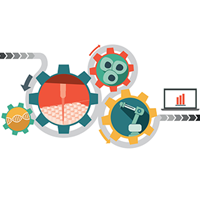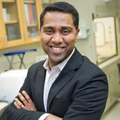Automated Manufacturing of Dendritic Cell Therapies: Progress & Challenges
Cell Gene Therapy Insights 2017; 3(8), 603-606.
10.18609/cgti.2017.061
You recently started working with dendritic cell therapy. How did you become interested in this?
My lab has worked on technologies for cell processing and separation for over 12 years now. It was on the basis of this work that we were approached by a collaborator who highlighted the problem of dendritic cell culture and that’s when I started working with dendritic cells.
Dendritic cell (DC) therapy against cancer has been studied extensively over the past two decades. DC is the most powerful antigen-presenting cell in the immune system and it has been a popular choice as a basis for personalized cellular immunotherapies.
Typically, in DC-based cancer immunotherapy, DCs derived from the patient is armed with appropriate tumor-associated antigens, followed by DC stimulation and reintroduction into patients. It has been shown to reactivate tumor-specific T cells in both preclinical and clinical settings. There is also considerable interest in using these cells in combination with other immunotherapies to fight cancer.
Provenge was the first DC-based immunotherapy to be approved. It had limited success not only because of its efficacy, but also significantly because of the manufacturing challenges. However, even despite its challenges, Provenge is still being used to treat around 4,000 patients a year, highlighting the potential of dendritic cells and specifying the need to address the manufacturing issues.
Culturing DCs is a standard process in which DCs are typically obtained from monocytes and peripheral blood. The process of turning them into DCs is a 20-year-old protocol and it’s well established and effective. However, automating the protocol is challenging due to a number of reasons and that’s what brought us into the field.
What are the barriers to advancing DC therapy to the clinic?
As I alluded to, manufacturing is one of the main barriers in advancing DC therapy to the clinic. The tricky part with DCs is that you start out with an adherent cell type, monocytes, and then they turn into larger, non-adherent cells. Therefore, any automation platform must be able to accommodate both adherent and non-adherent cells.
The other barrier has been the science behind DC therapy, which has been steadily advancing, although perhaps not receiving enough credit as it should be as a field. Provenge was a therapy that had essentially a single target in terms of its capability and modification. Whereas the DC therapies that are under investigation and in early clinical trials now have broad range of targets targeting various patient-specific mutations. Therefore, I think the therapies have grown more complex and powerful, but it is a slow process.
One reason why automated platforms for DCs have not received much attention thus far is the number of patients treated. The market size tends to be relatively small and therefore the major players have not devoted resources to the development of a customized DC therapy manufacturing system.
What progress has been made in automating the autologous DC manufacturing process?
This falls into two parts. On one hand, we have the more conventional and familiar process of large-scale cell manufacturing where cell culture is done in bags. With dendritic cells, however, culturing in bags is challenging and the yields are not as high with respect to the amount of end product you get using the given amount of starting material.
On the other hand is the fact that DCs can be generated with pretty high yields in flat cell culture plastic ware like T-flasks or well plates. These combination of cell attachment properties and surface area are optimal for DCs. We still have a large number of researchers and early clinical trial experts performing their work with T-flasks. However, these culture systems are not scalable.
Therefore, the challenge with automating the cell culture process is that on one hand you have something that is scalable but low yield, and on the other hand something else that is high yield but not scalable. Our work in this area aims to find a way to address these twin challenges.
Your group has received funding to develop an automated method of DC generation for clinical application. Could you elaborate on this?
Our funding in this area is for the development of an automated platform that can generate DCs with high yield in a fully automated and scalable manner. Right now we are able to generate DCs with high yield, a yield that matches or exceeds that of the planar T-flasks. We are working now on scaling up to achieve enough numbers of DCs for clinical applications. Additionally, we are trying to incorporate multiple steps involved in manufacturing of DC therapy, which include the maturation and pulsing of those cells with tumor specific antigens. The workflow is very different from that of, for instance, CAR-T manufacturing and that’s part of the challenge. It requires instrumentation and automated systems that are customized exclusively for DCs.
What advantage could this method offer compared to already existing automated approaches? Could the automated system be used as a platform for other cell types?
The existing automated approaches were not specifically designed for DCs. The peculiarity of DC cultures, namely the adherent and non-adherent combination, makes it very difficult to adapt those platforms for DC manufacturing. The expectation is that our system will combine the high yield of planar plasticware with the scalability of bag-based culture system and that’s what we’re driving towards.
At this time we are focusing exclusively on DCs; however, there are likely other cell types that could benefit from the features of our system.
In terms of automating DC manufacturing, how do you see the field progressing in the next 3–5 years?
I don’t expect there to be a single dominant type of cell therapy. My view is that we will see a broad range of cell therapies, and a range of combinations where the cell therapies are combined with biologics to address a broad range of indications. Within this broad range I think that DCs will likely play a significant role.
Affiliation
Shashi Murthy
Department of Chemical Engineering, Northeastern University, MA, USA.
This work is licensed under a Creative Commons Attribution- NonCommercial – NoDerivatives 4.0 International License.


